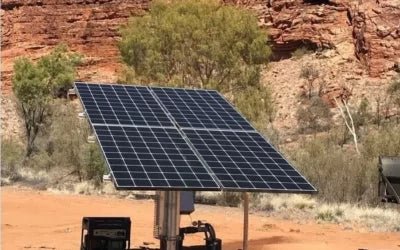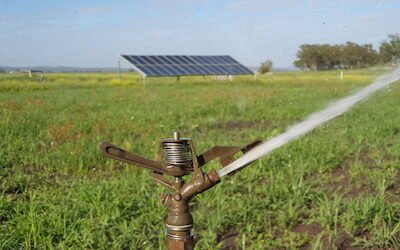In recent years, the adoption of sustainable and eco-friendly practices has gained momentum across various industries, including agriculture and livestock management. Among these practices, the use of solar pumps for watering livestock has emerged as a viable and environmentally friendly solution. Solar pumps provide an efficient, cost-effective, and sustainable alternative to traditional water pumping methods.
This article explores the benefits and considerations of using solar pumps for livestock watering, highlighting the advantages they offer to station operators across Australia and the Pacific.

How do water pumps distribute water to livestock?
There are a number of components that make up a solar water pumping system to water livestock. We’ll go through each of these below:
Solar Panels
Solar water pumps are powered by photovoltaic (PV) solar panels, which convert sunlight into electricity. These panels are typically installed in a location where they receive maximum exposure to sunlight throughout the day.
Solar Controller
A solar controller is used to regulate the flow of electricity from the solar panels to the pump. It ensures that the pump operates efficiently and prevents overcharging or damage to the system’s batteries.
Direct Current (DC) Motor
Most standard solar pumps typically use a direct current (DC) motor that runs on the electricity generated by the solar panels. The motor operates at variable speeds based on the available sunlight.
Solar Water Pump
The DC motor is connected to the water pump, which may be a centrifugal pump or a positive displacement pump. Centrifugal pumps are commonly used for livestock watering. The pump draws water from a bore, dam, pond or other water source and pushes it through pipes or hoses to the desired location.
Distribution Network
The water pumped by the solar water pump is delivered to the livestock through gravity-fed systems, watering troughs, or automated waterers. The distribution system can be set up according to the specific requirements of the farm and livestock.
Solar water pump systems like LORENTZ offers remote monitoring and management to ensure optimal operation, with minimal time investment. This may include sensors, switches, or controllers that monitor water levels, pressure, or pump performance, allowing for efficient management and maintenance.
Battery Storage (Optional)
In some solar pump systems, batteries are used to store excess solar energy generated during the day. These batteries store the energy and provide power to the pump during periods of low sunlight or at night, ensuring a continuous water supply for livestock.
What to consider before choosing a solar pump:
While solar pumps offer numerous benefits, there are a few considerations for station operators interested in adopting this technology which an accredited LORENTZ dealer can help you to assess:

Water source
The water source and depth of water is important to determine whether you need a submersible or surface pump.
Water requirement
Understand exactly what your daily water requirements are and the amount of sunlight that exists in the target location to help determine what type of solar pump you need.
Elevation height of water
Understanding the elevation height of the water source is crucial when using a solar pump as it determines the pump’s capability to lift water effectively and ensures proper sizing and efficient operation of the system..
Water storage and distribution
Plan and design an appropriate water storage and distribution system to ensure livestock have access to water even during cloudy days or at night when the pump may not be operational.
An increasing adoption of solar pumps

Cost-effectiveness
Solar pumps offer cost savings over the long term. Once installed, solar-powered systems rely on free solar energy, eliminating the need for electricity or fuel expenses which both continue to rise. This reduces operational costs and provides a significant return on investment over the system’s lifespan (a solar pump from a reputable brand like LORENTZ, has a 2 year warranty but will commonly lasts at least 5 years, with many examples of pumps running for 10 or more years).
Energy independence
Solar pumps provide energy independence to station operators, especially those located in very remote or off-grid areas. By utilising the abundant solar energy available, especially towards the north of the country, station operators don’t have to rely on costly grid connections or fossil fuel-based generators, ensuring a consistent and reliable water supply for their livestock.
Environmental sustainability
The focus on sustainable and eco-friendly practices has driven the adoption of solar pumps. By harnessing renewable solar energy, station operators reduce greenhouse gas emissions and their carbon footprint. Solar pumps contribute to cleaner air quality and mitigate the environmental impact associated with conventional pumping methods.
Technological advancements
Technological advancements in solar panel efficiency and pump design have made solar pumps more reliable and efficient. High-quality solar panels and controllers, like the ones LORENTZ offers are capable of generating significant power even in low-light conditions, ensuring continuous water supply for livestock even on cloudy days.
Government incentives and support
Many governments and organisations offer financial incentives, subsidies, and support programs to promote the adoption of renewable energy technologies, including solar pumps. These incentives make solar pump systems more affordable and financially attractive for station operators.
Longevity and low maintenance
Solar pumps are known for their durability and low maintenance requirements. With fewer moving parts and no reliance on consumable fuels, solar pumps have a longer lifespan and require minimal upkeep, reducing maintenance costs and time spent on repairs.
Scalability and adaptability
Solar pump systems are highly scalable and can be tailored to meet the specific water needs of different livestock farming operations. Whether it’s a small family farm or a large commercial enterprise, solar pumps can be designed to accommodate the desired water flow rate and distribution requirements.
Positive impact on animal welfare
Reliable access to clean water is crucial for the health and welfare of livestock. Solar pumps provide a consistent and clean water supply, promoting better hydration and overall animal well-being.
As station operators seek more sustainable and efficient water management solutions, solar pumps offer a compelling alternative that aligns with their economic and environmental goals.
To assess what solar pumps will work best for your requirements, speak to an expert water pump specialist today.







